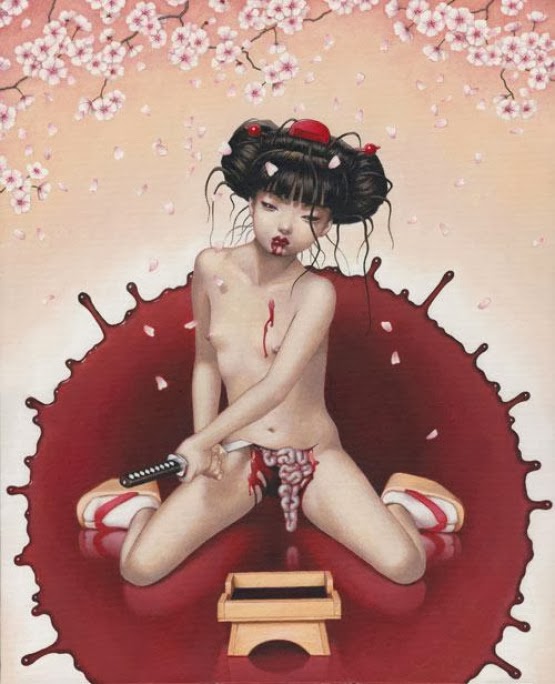 |
| interior album cover for Deicide's Once Upon the Cross (1995) |
Δευτέρα 31 Μαρτίου 2014
Trevor Brown
Trevor Brown is an English artist from London presently living in Japan whose work explores paraphilias, such as pedophilia, BDSM, and other fetish themes. Innocence, violence, misogyny, and Japanese popular culture all collide in Brown's art. His interviews and art have been featured in numerous publications worldwide, most recently on the cover of Gothic & Lolita Bible in Japan. His work also appears on a variety of book and record covers (album cover for Deicide's Once Upon the Cross (1995). He has illustrated for Coup de Grace an edition of Friedrich Nietzsche's Der Antichrist. Brown has also had several books of his art published. Brown was involved in a copyright controversy with the electronic band Crystal Castles, who had begun using Brown's work in 2006 on merchandise without the artist's permission. A financial settlement was reached in 2008.
Δευτέρα 24 Μαρτίου 2014
Kate MacDowell
Kate MacDowell is a contemporary sculptor. We read in her SITE:
We do not want merely to see beauty, though, God knows, even that is bounty enough. We want something else which can hardly be put into words--to be united with the beauty we see, to pass into it, to receive it into ourselves, to bathe in it, to become part of it. – C.S. Lewis.
In my work this romantic ideal of union with the natural world conflicts with our contemporary impact on the environment. These pieces are in part responses to environmental stressors including climate change, toxic pollution, and gm crops. They also borrow from myth, art history, figures of speech and other cultural touchstones. In some pieces aspects of the human figure stand-in for ourselves and act out sometimes harrowing, sometimes humorous transformations which illustrate our current relationship with the natural world. In others, animals take on anthropomorphic qualities when they are given safety equipment to attempt to protect them from man-made environmental threats. In each case the union between man and nature is shown to be one of friction and discomfort with the disturbing implication that we too are vulnerable to being victimized by our destructive practices.... I see each piece as a captured and preserved specimen, a painstaking record of endangered natural forms and a commentary on our own culpability.
Δευτέρα 17 Μαρτίου 2014
Boris Artzybasheff
Boris Artzybasheff (1899 – 1965) was an American illustrator active in the United States, notable for his strongly worked and often surreal designs. Artzybasheff was probably known best for his magazine art. He illustrated the major American magazines Life, Fortune, and Time (including more than 200 Time Magazine covers over a 24-year span between 1941 and 1965.) He drew a series of surreal anti-nazi illustrations. During World War II, he also served an expert advisor to the U.S. Department of State, Psychological Warfare Branch. After 1940, he devoted himself to commercial art, including advertisements for Xerox, Shell Oil, Pan Am, etc. His graphic style is striking. In commercial work he explored grotesque experiments in anthropomorphism, where toiling machines displayed distinctly human attributes. In his personal work, he explored the depiction of vivid and extreme ranges of human psychology and emotion.
Δευτέρα 10 Μαρτίου 2014
František Drtikol
František Drtikol (1883 – 1961) was a Czech photographer of international renown. He is especially known for his characteristically epic photographs, often nudes and portraits. Drtikol made many portraits of very important people and nudes which show development from pictorialism and symbolism to modern composite pictures of the nude body with geometric decorations and thrown shadows, where it is possible to find a number of parallels with the avant-garde works of the period. These are reminiscent of Cubism, and at the same time his nudes suggest the kind of movement that was characteristic of the futurism aesthetic.
I present some of his more dark and macabre photos with erotic attitude, salome, death and the maiden (erotic playful attitude with death in contrast with the warning message of the classic theme) and the crucified woman























I4w~~60_57.JPG)






















.jpg)


